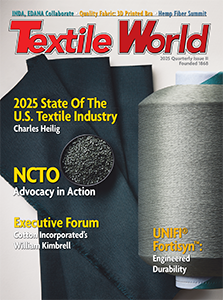
HOUSTON — December 7, 2017 — Device’s braided qubits could form component of topological quantum computer. Rice University physicists dedicated to creating the working components of a fault-tolerant quantum computer have succeeded in creating a previously unseen state of matter.
Rice’s “topological excitonic insulators” are made of sheets of semiconductors (top) that become insulators at a critical temperature around 10 kelvins. At the critical point, a superfluid quantum liquid of excitons — pairs of negatively charged electrons (blue dots) and positively charged electron holes (red dots) — forms inside the devices (bottom) and electricity ceases to pass through them. (Image courtesy of R. Du/Rice University)
The “topological excitonic insulator” was observed in tests at Rice by an international team from the United States and China. The researchers report their findings this week in the journal Nature Communications. Their device could potentially be used in a topological quantum computer, a type of quantum computer that stores information in quantum particles that are “braided” together like knots that are not easily broken. These stable, braided “topological” quantum bits, or topological qubits, could overcome one of the primary limitations of quantum computing today: Qubits that are nontopological easily “decohere” and lose the information they are storing.
Conventional computers use binary data, information that is stored as ones or zeros. Thanks to the quirks of quantum mechanics, qubits can represent both ones, zeros and a third state that’s both a one and a zero at the same time.
This third state can be used to speed up computation, so much so that a quantum computer with just a few dozen qubits could finish some computations as quickly as a microchip with a billion binary transistors.

In the new study, Rice physicist Rui-Rui Du and former Rice graduate student Lingjie Du (no relation) collaborated with researchers from Rice, Peking University and the Chinese Academy of Sciences to create excitonic insulators made of tiny slivers of ultrapure, stacked semiconductors. The devices, which are no more than 100 microns wide, contain a sheet of indium arsenide atop a sheet of gallium antimony. When cooled in a bath of liquid helium to a critically low temperature around 10 kelvins, a superfluid quantum liquid forms inside the devices and electricity ceases to pass through them.
“This is very much like the process in a superconductor, where you have electrons that are attracted to one another to form pairs that flow without resistance,” said Rui-Rui Du, a professor of physics and astronomy at Rice and a researcher at the Rice Center for Quantum Materials (RCQM). “In our case, electrons pair with positively charged ‘electron holes’ to create a superfluid with a net charge of zero.”
Lingjie Du, now a postdoctoral researcher at Columbia University, said, “It’s a collective effect, so to an outside observer the system conducts electricity normally until it’s cooled to the critical temperature, where it suddenly changes phase to become a perfect insulator.”

To prove that the device was the long-sought excitonic insulator, the team first had to show the fluid was a quantum condensate. That task fell to Xinwei Li, a graduate student in the laboratory of RCQM researcher Junichiro Kono. Li and Kono, a professor of electrical and computer engineering at Rice, shined terahertz waves through the devices as they were cooled to the critical temperature and found that the samples absorbed terahertz energy in two distinct bands — a signature of quantum condensation.
Showing the device was topological involved testing for electrical conduction in a one-dimensional band around their perimeter.
“This novel property of the edge state is the thing that people are very interested in,” Rui-Rui Du said. “This edge state has no electrical resistance, and you get conduction in which electrons are tied to their spin moment. If they have one type of spin, they go clockwise and if they have the other they go counterclockwise.”
Braiding circuits built on these opposing electron streams would have inherent topological signatures that could be used to form fault-tolerant qubits.
“The other beauty of this is that the same principles still apply at room temperature,” Rui-Rui Du said. “There are atomically layered materials such as tungsten disulfide that could potentially be used to create this same effect at room temperature, provided they could be made in pure enough form.”
Additional co-authors include Wenkai Lou and Kai Chang of the Chinese Academy of Sciences in Beijing and Gerard Sullivan of Teledyne Scientific Imaging in Thousand Oaks, Calif. The research was supported by the Department of Energy, the National Science Foundation (NSF) and the National Science Foundation of China. Some experiments were performed at the National High Magnetic Field Laboratory, which is supported by NSF and the state of Florida.
Posted December 7, 2017
Source: Rice University’s Office of Public Affairs




